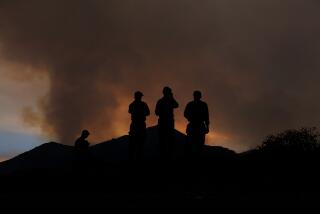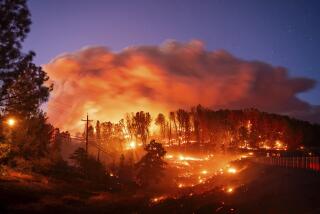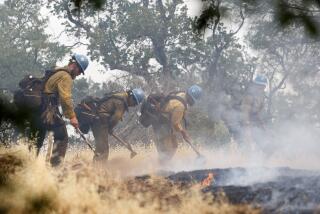Firefighters Blast Trench to Divert Blaze Threatening Alaska Pipeline
- Share via
Firefighters used explosives to halt a 121,600-acre blaze that threatened the Alaska oil pipeline, but other wildfires raged Wednesday over another 28,000 acres in six other drought-weary Western states from California to South Dakota.
Fireworks were blamed for California’s worst blaze, a 2,550-acre brush fire west of Yosemite National Park, not far from the site of last year’s devastating forest fire in Tuolumne County. Authorities seized a camera that may contain photos of the person whose illegal bottle rocket ignited the blaze.
Los Padres Fire
Meanwhile, about 850 acres of dry chaparral were blackened by a fire in Los Padres National Forest 14 miles east of San Luis Obispo, while fire crews supported by air tankers moved in on Lake Isabella northeast of Bakersfield to contain a 570-acre grass fire caused by a motorist’s carelessly discarded cigarette. No structures were threatened by either blaze.
Spokesmen for the sprawling Camp Pendleton Marine Corps base in San Diego County reported that fire burned between 250 and 300 acres at the northern end of the base, near the Orange County line, before it was brought under control. No structures were damaged and no injuries were reported.
Elsewhere, fire crews used explosives to cut a 3-mile-long trench down to icy, moist Alaskan permafrost, the permanently frozen subsoil, to divert a wind-fanned lightning fire from the 800-mile transalaska oil pipeline, the Bureau of Land Management said. The pipeline carries one-fourth of the U.S. oil production from Prudhoe Bay to the port of Valdez.
The 121,600-acre fire continued to burn in Alaska’s 8.1-million-acre Yukon Flats National Wildlife Refuge north of Fairbanks, where several other scattered fires, totaling about 137,500 acres, burned black spruce forests and alpine tundra.
Homes Evacuated
In Wyoming, scores of firefighters fought a 1,300-acre fireworks fire near a Bridger-Teton National Forest campground, causing the evacuation of 47 summer homes. Three other fires, the largest 1,800 acres, were being allowed to burn themselves out in Yellowstone National Park, while a 2-week-old, 1,650-acre lightning fire in Shoshone National Forest was being surrounded.
In South Dakota, a 6,000-acre lightning-sparked forest fire forced the closure of Custer State Park and sent smoke billowing over Mt. Rushmore 5 miles away. About 600 people have been evacuated from the 73,000-acre state park, the second-largest in the nation, but the fire posed no immediate threat to the famed mountain carving, which remained open to tourists.
In Montana, a 3-week-old, 3,400-acre lightning fire in Custer National Forest threatened the Stillwater platinum mine, a ranch and several cabins but was expected to be contained by Friday evening.
Down in Arizona, flames blackened 8,700 acres of desert brush in the Tonto National Forest 100 miles north of Phoenix before being contained. Full control was expected by Friday evening.
In Utah, more than 100 firefighters were rushed in to face a 750-acre fire in Zion National Park. The fire, sparked by lightning on June 19, was being allowed to burn itself out until winds whipped it out of control.
All of the fires were made worse by erratic winds, tinder-dry brush, high temperatures and low humidity. Several incidents--particularly the Mariposa County fire near Yosemite and the Custer blaze in South Dakota--were further hampered by very steep and difficult terrain, fire officials said.
Despite the inhospitable circumstances, authorities reported few injuries to firefighters. At most fires, the worst problems consisted of heat exhaustion, sprains, cuts and bruises.
One South Dakota firefighter reportedly suffered a badly bruised or broken leg. A volunteer firefighter was taken to the Salt Lake City Burn Center with serious burns on his hands, arms and chest.
More to Read
Sign up for Essential California
The most important California stories and recommendations in your inbox every morning.
You may occasionally receive promotional content from the Los Angeles Times.










